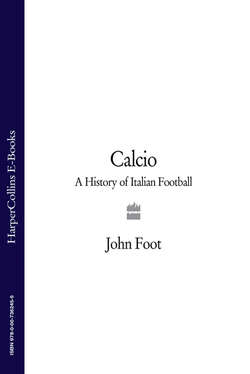Читать книгу Calcio: A History of Italian Football - John Foot - Страница 27
The referees’ strike of 1925 and the first ‘suspicions’
ОглавлениеReferees in the Italian leagues were increasingly unhappy with the pressure they were under by the mid-1920s. Giovanni Mauro, president of the referees’ association (the AIA), called time and again for more protection for his members and less control over their activities. His organization was vehemently opposed to a blacklist of referees that had been compiled – in secret – by certain powerful clubs. In 1925 Mauro wrote in his magazine, The Referee, that there was a need to re-establish ‘minimal levels of deference and respect towards referees whose current position is no longer like that of a judge, but more like that of a clown’. In 1926 a match between Casale and Torino was declared null and void because the referee had not officiated with ‘the correct serenity of spirit’. This was code (and remains so, even today) for clearly biased refereeing. This besmirching of their reputation pushed the referees into strike action. Almost everyone in Italy had gone on strike in the wake of World War One. There was even a priests’ strike. However, referees had never withdrawn their labour. In the mid-1920s this taboo was broken.
The action was moderate. The men in black simply refused to go to matches. Someone as conservative as Mauro, who had often linked his job to a lofty patriotic ideal, was hardly likely to organize picket lines and burning braziers outside grounds. In any case, the very threat of such a strike gave fascism a perfect opportunity to impose its will on Italian football. A commission was set up to draw up plans for sweeping reforms that would bring an end to the chaos in the game. In 1926, this led to the Viareggio Charter, the most important set of rules since 1909 and the basis for calcio’s re-organization under the regime.35
